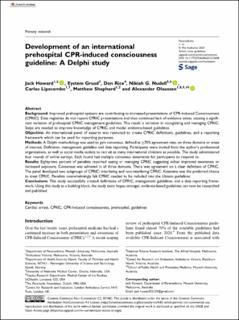| dc.description.abstract | Background:Improved prehospital systems are contributing to increased presentations of CPR-Induced Consciousness(CPRIC). Data registries do not report CPRIC presentations and thus continued lack of evidence exists, causing a signifi-cant variation of prehospital CPRIC management guidelines. The result is variation in recognizing and managing CPRIC.Steps are needed to improve knowledge of CPRIC and model evidence-based guidelines.Objective:An international panel of experts was recruited to create CPRIC definitions, guidelines, and a reportingframework which can be used for reporting purposes.Methods:A Delphi methodology was used to gain consensus, defined as≥70% agreement rate, on three domains or areasof interest: Definition, management guideline and data reporting. Participants were invited from the author’sprofessionalorganizations, as well as social media outlets to recruit as many international clinicians as possible. The study administeredfour rounds of online surveys. Each round had multiple consensus statements for participants to respond to.Results:Eighty-two percent of panelists reported seeing or managing CPRIC suggesting either improved awareness orincreased exposure. Consensus was achieved in all three domains. There was agreement on a clear definition of CPRIC.The panel developed two subgroups of CPRIC; interfering and non-interfering CPRIC. Ketamine was the preferred choiceto treat CPRIC. Panelists overwhelmingly felt CPRIC needed to be included into the Utstein guidelines.Conclusions:This study successfully created definitions of CPRIC, management guidelines, and a data reporting frame-work. Using this study as a building block, the study team hopes stronger, evidence-based guidelines can now be researchedand published. | en_US |

